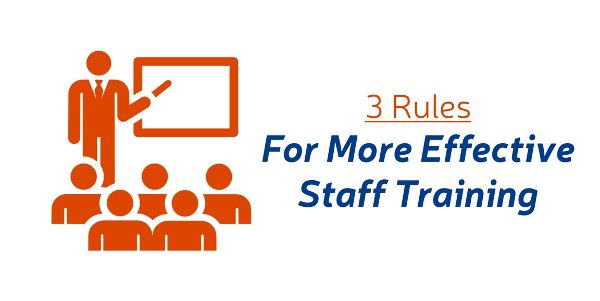3 Rules for More Effective Staff Training

I once had this amazing manager when I worked in the hospitality industry. Despite being the General Manager of a luxurious 5-star hotel, he stayed close to all the staff, being a rich source of inspiration to us. He didn’t attend any reputable Swiss hotel school or such. He just joined the industry at the bottom of the ladder. Throughout a few decades and a lot of training, he became the admirable leader that I had the chance to work with.
During my time in the hospitality industry I underwent many trainings. And in most of them the focus on peer coaching, on-the-job learning, and interactive workshops was impressive. That’s why, based on my own experience, I would like to propose the following three rules for effective corporate training.
Rule #1: Customize the corporate training
People have different ways of acquiring knowledge and learning new skills. Some find it more comfortable reading the materials themselves and they only come to a trainer when they have questions. Others prefer new things being presented to them in an interactive way, be it in a classroom or via video tutorials.
You should ask the trainees for their preferences before planning any staff training. Make inquiries about the preferred method (self-study vs. coaching), their favourable environment (online, classroom, or on-the-job) and the pace they are comfortable with (an intensive short course, a long course with a fixed schedule or self-pacing).
If you don’t have the access to their references or can’t accommodate all the differences, refer to the effectiveness of previous training. What type of training brings the best results regarding a specific skill? A high ROI often signifies effective training. You will find more on measuring training results on the second part.
Examples of the various training you can provide to your employees:
- Online self-learning: share tutorial documents and videos on the company’s Google Drive.
- Online one-on-one courses, such as mYngle for learning a new language.
- Classrooms with a professional trainer.
- Intensive workshops.
- On-the-job training by a peer.
- Working in a different department to learn new skills.
When it comes to employee satisfaction, companies that offer more customized courses and opportunities for personal development often win. Don’t stop at skills that are essentials for an employee’s job, offer to broaden their horizon and career opportunities.
It is true that some people love their job and only want to excel at one thing. However, many others appreciate the chance to learn transferable skills, such as “how to manage a team” or “how to persuade others”. By asking your employees about what they want to learn, you show them that you care about their personal development as much as their contribution to the success of the company.
Rule #2: Evaluate the training
Once you decide the type of training to be given to certain employees, you need to find out how to measure the results. Never start training without setting specific goals. Write down the expectation for outcomes and estimate the return on investment.
Measurable Goals
The outcomes of training could be anything that has a positive impact on the business bottom line: a higher level of customer satisfaction, reduced operation costs, a better retention rate, etc. You need to decide which outcomes you want and how you measure them.
Evaluation during training
Donald Kirkpatrick, the author of many organisation training books, advised the four levels of evaluation. He proposed companies to do evaluation in each stage of the learning.
- Reaction: how trainees react to the materials or response during sessions
- Learning: what knowledge they acquire
- Behavior: what workplace behavior they have afterwards
- Results: the impact on performance
Evaluation tools include observation, feedback, surveys, and tests. These tools can be used in combination before, during and after any given training session.
Through observation, you can see, for example, if a training session is engaging and if there’s a change in behavior.
Feedback is the great way to get trainees to share more about their progress. Ask them immediately a session if they feel that the training is engaging and beneficial. Go deeper for improvement suggestions from the attendees. Let them know that you are open for feedback in the future while they start to apply what they have learned to do a better job.
While face-to-face feedback is the best way to build employee relationships, tools like 7 Geese, Small Improvement, or Impraise help to collect feedback online, instantly and/or anonymously. Some of those tools also enable you to create surveys and analyse the results faster. They reduce the administration cost of evaluation, compared with the traditional paper surveys and tests.
Return on Investment
Many organizations use ROI analysis to measure the success of training programs because of its straightforwardness and transferability. Basically, ROI analysis tells you how much money you get back on each dollar or euro you invest on training.
The concrete number validates any training program as a business tool. Besides, you can use it to justify the cost of training programs that you propose to the C-suite. As mentioned above, it can also help when you need to make a difficult choice between training methods. Hint: Go with the one with a higher ROI.
When using ROI, you need the total cost and the monetary benefits.
Training costs could include:
- Material production cost
- Payment for professional trainers
- Tradeoff between training time and working time
- Cost of online classes offered to employees and paid for by the company
- Evaluation cost
Monetary benefits could come from:
- An increase in productivity
- Income generated from new leads
- Lower turnover costs
Rule #3. Regular Follow-ups
While it is necessary to evaluate right after the training, don’t forget to follow up later when the trainees have the time to apply what they learn into their work, be it after two weeks or a few months. Let your employees know that their feedback is always welcome, especially the input on any future training.
Takeaways:
- Customize training programs to the needs and preferences of your employees
- Set up specific goals for any training program beforehand
- Evaluate training at every level to measure the results
- Provide assistance as trainees transfer learned skills and behaviors into their work
- Actively seek feedback from trainees
About the author:
 Quynh Nguyen writes about productivity for individuals and teams while travelling the world. She loves learning languages, riding a bike and having many nice cups of tea. Connect with her @QuynhThuNguyen or visit her at www.quynh.nl
Quynh Nguyen writes about productivity for individuals and teams while travelling the world. She loves learning languages, riding a bike and having many nice cups of tea. Connect with her @QuynhThuNguyen or visit her at www.quynh.nl
Explore posts in the same categories: HR topics and support